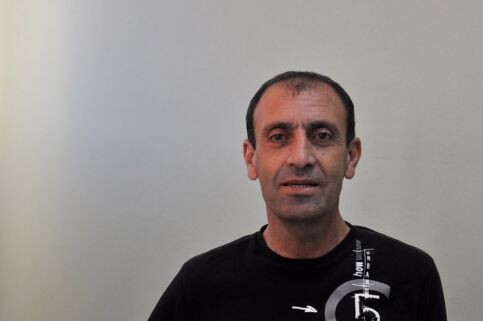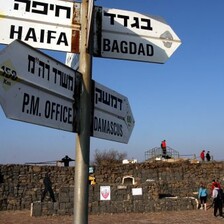The Electronic Intifada 28 January 2011

Taiseer Maray
Since the Syrian Golan Heights were occupied during the June 1967 War, the indigenous Arab population has resisted Israeli control. The Electronic Intifada contributor Adri Nieuwhof interviews Taiseer Maray, general director of the non-profit organization Golan for Development, about the situation in the occupied Golan Heights.
Adri Nieuwhof: Tell us about the activities of the Golan for Development.
Taiseer Maray: The Golan for Development was established in 1991 in the occupied Golan Heights. We are working on development projects as a method to resist Israel’s occupation and control. We provide basic services in many different projects. We cover most of the health services in all five Arab villages, and we increase awareness of health issues. We offer agricultural outreach services to the farmers. We have a theater project, and in our music center fifty pupils receive music lessons. We run a kindergarten for children, we organize teaching courses and activities for women. We also developed a project on alternative tourism. With our research project we monitor the Israeli settlements in the Golan and relevant issues in our society. We are innovative. For example, we have developed a new technique of growing shitake mushrooms on apple wood. We researched and published information about this.
AN: The media does not cover the situation in the occupied Golan Heights. What can you tell us about it?
TM: In 1967, before the June War, 130,000 Arabs lived in 139 villages and more than sixty farms in the Syrian Golan Heights. After the war, about 60,000 to 90,000 Syrians remained in the Golan. Within two months following the June [1967] war, the Israeli forces transferred the rest of the population. People were pushed out of their houses. Only about 6,300 Syrians remained in five villages, mainly farmers. People were frightened at that time. You don’t hear much about us because of our small numbers. In 1981, Israel annexed the Golan Heights. The people resisted, there were clashes and demonstrations. We were attractive to the press then. Israel tried to force us to take Israeli citizenship. We refused.
In the 1990s, Israel understood that putting pressure on the Arabs in the Golan Heights led to more unity and resistance. Now they want us to assimilate into Israeli society. We don’t face hard Israeli policies like in the 1970s and 1980s. They are trying to destroy our cultural heritage by forcing us to assimilate. The fight is about education, and against the silent attack on our cultural heritage and identity. It makes resistance more difficult. Israel tries to control the brains of the new generation through education. We have to study Hebrew, Zionist history, Jewish history. The culture of Arabs that is taught is in the best case half the truth. In Syria, we have a culture of resisting occupations, by the French, the Ottomans. Our resistance is reflected in our poetry, but the Arab poetry that is taught in school is about love. The Israeli educational curriculum brainwashes the youth.
AN: What are Israel’s motivations for maintaining its occupation of the Golan Heights?
TM: It goes back to the history of the Zionist movement. The Golan Heights has been part of Zionist ambition since its establishment. In the literature you find how the Zionists asked the British to include the Golan Heights in the plans for the new Jewish state. Water is the main reason for Israel to occupy the Golan Heights. The Jordan River springs into the Golan Heights. We in the Golan get about 1,000 mm of rain per year. About 25 percent of the water Israel uses is from the Golan Heights. The biggest water company from Israel, Eden Springs, bottles our water in a factory on our land and exports it worldwide.
Another reason is that we have very fertile land. Since 1967, Israel has used all the potential of the Golan Heights: agriculture, tourism, minerals, grazing land, vineyards. Israeli wine produced from grapes from the vineyards in the Golan Heights is sold in the Netherlands. Flowers grown by Israel in the Golan are exported, also to the Netherlands. There is an Israeli olive oil factory in the Golan. We have lots of Israeli industries on our land.
AN: What does the Israeli occupation look like for the Arabs in the Golan Heights?
TM: In the 43 years of the Israeli occupation we have seen different strategies. The first ten years we were under military rule. Hundreds of people were taken to jail for political resistance in the 1970s and 1980s. You were taken to jail for discussing politics. After the annexation of the Golan Heights in 1981, we resisted and had clashes with the Israeli military forces. They tried to suppress and break us. We resisted and still do not have Israeli citizenship. Israel’s policies change. Now, they opened the gates to work, to assimilate us into Israeli society.
We fight about land and water resources. We fight to cultivate our land, while the settlers have free access to land and free access to water. Arab farmers may only use 150 cubic meters per dunam, which is one thousand square meters. A settler may use 700 cubic meters for one dunam. Water costs us about $1 per cubic meter, settlers pay $0.25 cents. The last four to five years Israel has uprooted more than 10,000 apple trees. Israel claimed it was state land. People went to the land collectively and replanted it with apple trees.
The farmers in the Arab villages in the Golan produce forty percent of the apples and fifty percent of the cherries for the Israeli market. We want to export our produce to the occupied West Bank and Gaza, but we don’t have access to them. We want to export to Europe. Maybe Fair Trade could be an option.
The last four years we could sell about ten percent of our apples to the Syrian market — to Damascus. We negotiated that the apples can pass the demarcation line with Syria. And now Israel tries to use it for political pressure. To use the sale of our apples as an example of normalization. But our apples are a Syrian product, grown by Syrian farmers on our land with our water. The apples are sold to our government in Damascus.
We fight about the education system. We have a big fight about building areas and rights. The municipalities in the Golan Heights are not elected. Israel appoints the mayors. Since 1981 we are forced to pay taxes but we receive nothing in return. We pay more taxes than the settlers. Our population grew from 6,300 in 1967 to 21,000. Israel controls the land near our villages to claim it for future needs of the settlers. We are fed up with it. With a few thousand people we went to the mountain near the village and opened roads. We are going to hand out our land to villagers to build on it.
AN: Do you see similarities between the occupation of the Golan Heights and the occupation of the West Bank and the Gaza Strip?
TM: We are the same people under the same occupation. At present our reality is different. The political prisoners of the Golan Heights spend their time in jail with Palestinians from the West Bank and Gaza. People say the first Palestinian intifada was inspired by the resistance in the Golan Heights. The Palestinians supported our struggle. We had a six-month strike and could not survive without the support of the Palestinians from the West Bank, Gaza and Israel. The first Palestinian intifada was a sort of continuation of what happened in the Golan Heights in the 1980s. We had lots of demonstrations to support the Palestinians. In 2008, during Israel’s invasion of Gaza, we collected food and sent trucks to Gaza. We keep close relations, we have the same struggle against the same aggressor. We have the same policy, the same goals. Israel tries to limit our development.
AN: What is the dream of the Arabs living under occupation in the Golan Heights for the future?
TM: Freedom for all of us. We dream that the Golan Heights will be given back to Syria. That Palestinians should be liberated and have their own state. We dream of the liberation of the Jewish people from the Zionist ideology. We dream of a Middle East where we have equal rights. We are not against Jews. No, we should be equal. I want to see Israel become a free, democratic country with no fascism and racism. This is an important step for our liberation from the Israeli occupation.
Photo by Ayman Abu Jaba/Golan for Development.
Adri Nieuwhof is a consultant and human rights advocate.




